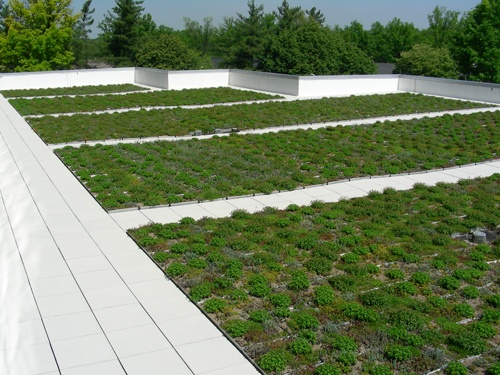Today’s roofing industry is seeing intensified interest in products that are made from recycled materials and promote energy efficiency and sustainability. Indeed, the industry is on the “environmental fast track” with roofing manufacturers, distributors and contractors offering more environmentally friendly products and services.
One “green” roofing product making the news is the “vegetative roof,” or “green roof,” which is a roof system composed of living plants and vegetation installed on an existing or new roof structure. For example, the Chicago Department of Aviation (CDA) celebrated Earth Week by highlighting 15 structures at its O’Hare and Midway airports designed with green roof systems.
Totaling eight acres of green roof coverage, the buildings demonstrate the CDA’s commitment to reducing its environmental impact on neighboring communities and promoting green practices. In the past decade, the department has prioritized green building design and construction on all new airport facilities, including two air traffic control towers, two cargo buildings and a rental car agency at O'Hare, as well as a rental car facility at Midway.
BENEFITS OF VEGETATIVE (GREEN) ROOFS
While the green roof concept is certainly not a new one, the benefits of the more contemporary intensive and extensive designs are numerous,
according to BCC Research analyst Lisa Marshall. Vegetative roofs help reduce the increased collective heat generated by built-up, urban areas, known as “urban heat-island effect.”
The systems help in storm water management by intercepting, delaying and absorbing rain water. Also, they can increase the useful life of the roof, in many cases up to twice the life of a typical roofing system, while reducing the total amount of energy consumption due to increased insulation values and thermal mass.
“Many studies now indicate a direct correlation between the decreased ambient air temperature and cooling energy use. In general, for every 1°F drop in temperature, there is roughly a 1.2% drop in cooling energy use,” says Marshall.
VEGETATIVE (GREEN) ROOF SYSTEMS
All vegetative roof systems consist of four basic components: a waterproofing layer, a drainage layer, a growing medium and, lastly, the vegetation. Some vegetative roofs also include root retention or irrigation systems, but they aren’t essential.
There are two types of vegetative roof systems: extensive or intensive systems, explains Marshall. Intensive systems feature deeper layers of soil and can usually support larger plant life including various crops, shrubs, and even small trees. Intensive systems can be harder to maintain, and depending on the plants used, are significantly heavier than extensive systems, ranging from 80 pounds to more than 120 pounds per square foot. In general, intensive systems are designed to be accessible for relaxation and/or harvesting. In some cases, intensive green roofs have literally become part of the usable floor space, also supplying actual food production for buildings such as the University of Florida’s Institute of Food and Agricultural Sciences, she says.
Most residential applications are composed of extensive roof systems. An extensive system features many smaller, lower plants such as succulents, grasses and mosses. They typically require thinner layers of soil (roughly 1 in. to 6 in. deep), and plants usually produce only a few inches of foliage. Extensive systems usually have less of an impact on the actual roof structure, weighing anywhere from 10 pounds to 50 pounds per square foot on average, and most are generally accessible only for routine maintenance.
CHICAGO LEEDING THE WAY
Since 2008, six buildings constructed at Chicago's airports have earned U.S. Green Building Council LEED certification.
The newest green roof at O'Hare is on the Federal Aviation Administration (FAA) South Air Traffic Control Tower, which opened last year. The tower, designed to achieve LEED Gold certification, also includes a geothermal energy system and other sustainable features. The FAA North Air Traffic Control Tower, which was constructed in 2008, was the first FAA tower to feature a green roof and the first to achieve U.S. Green Building Council LEED Silver certification.
There are programs and incentives available to homeowners building new or converting existing homes into environmentally-conscious “green” homes and neighborhoods, as well.
VEGETATIVE (GREEN) ROOF MARKET
The most notable positive trend in the global roofing materials market was the high growth rates in value of environmentally responsible products. The market segments for these products (reflective, building-integrated photovoltaic [BIPV)]and green roof) are small (each represents less than 0.1% of the total residential market value), says Marshall. But all grew at rates between 7.5% and 10% from 2013 to 2014, advances driven by the availability of incentives, including government tax credits, as well as boosted overall demand for eco-friendlier residential roofing products.
Overall, green roofing systems account for less than 1% of the total market value and less than 1% of the total market volume in 2015, according to Marshall. She maintains that green buildings in both residential and commercial sectors are positioned to withstand the current economic recession in the U.S. due to the popularity of the idea that sustainability can help building stakeholders cut their costs in the long term.
“There is a growing demand for high-efficiency buildings, and due to enticing state and federal tax incentives, the green roof industry should survive the recession in both commercial and residential markets,” she says. “Total market volume for vegetative roofs grew just over 12% in 2014 and another 17% in 2015. By 2020, market volume is expected to grow at a five-year compound annual growth rate (CAGR) of 8.4% and market value should grow at a 7.9% five-year CAGR.
Marshall
expects the North American residential roofing materials market to reach $6.5 billion and $7.8 billion in 2015 and 2020, respectively, reflecting a five-year CAGR of 3.8%.




